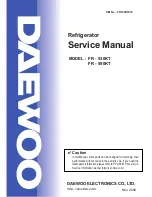
22
23
EN
4. OPERATION
Fridge defrosting
The fridge defrosting process is carried out
automatically every time the compressor
stops. The defrost water is automatically
routed to the drain port and into a tray placed
on the top of the compressor to the rear of
the appliance from which it evaporates.
Make sure the drain port on the fridge at the
rear of the appliance is kept clear.
Freezer defrosting
This appliance is designed to automatically
defrost in freezer compartment. It is not
required to unplug the appliance.
Noise from your appliance
You may notice some rather unusual noises.
The noises are caused by circulation of
refrigerant in the cooling system. It has be-
come more pronounced since the introduc-
tion of CFC free gases. This is not a fault and
will not affect the performance of your fridge.
Prolonged off periods
If the appliance is not in use for a long period
of time, proceed as follows:
Disconnect the appliance from the mains
supply.
Clean and dry the inside of the appliance
(see “Cleaning and maintenance”).
Leave the door open to prevent any unpleas-
ant smells from building up while the appli-
ance is not in use.
Notes for use
Do clean your appliance regularly.
Do check contents of the compartments
every so often.
Do store commercially prepared food in ac-
cordance with the instructions given on the
packets.
Do choose high quality fresh food and be
sure it is thoroughly clean before freezing it.
Do wrap all food in food quality polythene
bags or air tight containers and make sure
any air is excluded.
Do not store poisonous or any dangerous
substances in your freezer. It is designed for
the freezing of edible foodstuffs only.
Do not consume food which has been frozen
for an excessive length of time.
Do not leave the door open for long periods,
as this will make the appliance more costly to
run and cause excessive ice formation.
Do not use sharp objects such as knives to
remove the ice from the appliance. Only use
a plastic scraper.
Do no put hot food into the appliance. Let it
cool down to room temperature.
Do not put liquid-filled bottles or sealed cans
containing carbonated liquids into the freezer
as they may burst.
Do not give children ice-cream and wa-
ter ices direct from the freezer as the low
temperature may cause “freezer burns” on
the lips.
Do not try to keep frozen food which has
thawed; its should be eaten within 24 hours
or cooked and re-frozen.






































